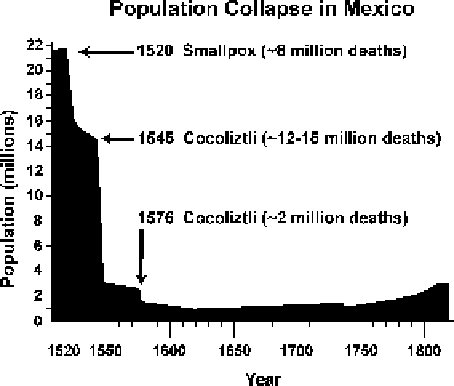Geoscience Reference
In-Depth Information
Fig. 10.13
The demographic
collapse in Mexico following
conquest in the sixteenth
century is illustrated with
population estimates from
heavy mortality in the 1540s
and 1570s has been linked to
indigenous hemorrhagic
fevers (i.e., 'cocoliztli') and
climate extremes by
population of Mexico did not
return to pre-conquest levels
until the twentieth century
'maximalists' such as Sherburne Cook and Woodrow Borah estimating 15-20 mil-
and the population estimates for Mexico shown in Fig.
10.13
are based on the work
The epidemic of 1519-1520 was certainly caused by smallpox and killed an
estimated 8 million native Mexicans during the war of conquest with Cortez
the catastrophic epidemics of 1545-1548 and 1576-1580, which killed an esti-
mated 12-15 million and 2-2.5 million people, respectively, were also the result
of introduced European or African diseases such as measles, smallpox, and typhus
killed an estimated 80% of the native population of Mexico, which in absolute and
percentage terms approaches the severity of the Black Death of bubonic plague from
1347 to 1351, when, conservatively, 25 million people perished in western Europe,
or about 50% of the population. But the devastating Mexican epidemics of 1545
and 1576 are now believed by some epidemiologists to have been indigenous hem-
orrhagic fevers called 'cocoliztli' and later 'matlazahuatl' (Nahuatl terms for 'pest').
These epidemics may have been misdiagnosed as smallpox and typhus due in part to
mistranslations of contemporary descriptions and the repetition of historical error.
Two recent articles in the epidemiological literature cite new translations from the
original Latin texts to make the convincing argument that the catastrophes of 1545
and 1576 were hemorrhagic fevers—probably caused by an indigenous agent, pos-
sibly with a rodent vector—that was leveraged by a sequence of climatic extremes
and aggravated by the appalling living conditions of the native people under the
encomienda system of New Spain.
cocoliztli by Dr. Francisco Hernandez, the proto-medico of New Spain and former

